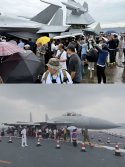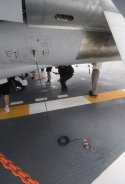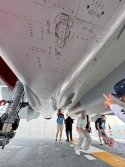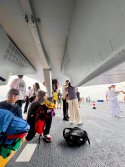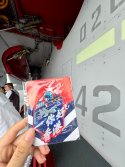I was told that WS-10B3 was significantly improved and is similar in performance to the Al-41F-1S(14tf-14.5tf emergency thrust), so unless J-15Ts were using the same engines as early batches of J-20 which was an Al-31FM2 variant with approx. 14.5tf of thrust, the improvement here would be significant.Al-31 has marginally less thrust than the latest WS-10 that J-15T will probably get, but holding all else equal the differences in capability of a J-15T using Al-31 versus a J-15T using a WS-10 is probably rather miniscule.
Taking that miniscule differences and comparing it to a standard recent batch production J-16 is not likely to be significant.
You are using an out of date browser. It may not display this or other websites correctly.
You should upgrade or use an alternative browser.
You should upgrade or use an alternative browser.
J-15 carrier fighter thread
- Thread starter Jeff Head
- Start date
I was told that WS-10B3 was significantly improved and is similar in performance to the Al-41F-1S(14tf-14.5tf emergency thrust), so unless J-15Ts were using the same engines as early batches of J-20 which was an Al-31FM2 variant with approx. 14.5tf of thrust, the improvement here would be significant.
You misunderstand me.
In terms of the actual improvement of thrust in context of engine parameters, sure it is not trivial.
What I am saying is in context of actual important capabilities that make up a modern tactical fighter aircraft, whatever boost in performance that J-15T's eventual WS-10 variant can offer relative to Al-31s are likely to be miniscule in context of the actual primary contributors to combat capability that J-15T and J-16 respectively hold.
Hello everyone,
I'd like to discuss an issue regarding the J-15. The J-15 has a major flaw: its 3x2 pylons, including the wingtip ones, are located on the outer, folding section of the wings. This means the J-15 cannot be armed with weapons unless its wings are unfolded, which severely impacts deck operational efficiency. In contrast, aircraft like the F/A-18 series and the F-35C have most of their hardpoints on the non-folding section. This results in the J-15 having only 6 "quick-load" hardpoints available in its folded state: the 2 under-intake pylons, 2 wing-root pylons, and 2 centerline fuselage pylons, in addition to the 6 non-quick-load pylons on the folding wing sections.
That's just a design characteristic which it retains from the original T-10K (and Su-33 I suppose) airframe configuration and is not able to be changed practically due to the inherent structural nature of the wings. And even if they wanted to change it, they wouldn't be able to just "fit in" additional wing stations on the inboard wing sections, -- they'd have to do painstaking structural redesign to increase the width of the aircraft's folded footprint by shifting the wing folding joint "outwards" which will increase the size of the aircraft's overall folded footprint, thus reducing deckspace efficiency for what is already a huge aircraft -- so choose your poison.
But one way of viewing the difference between J-15/T and its generational peer -- the F-18E/F Super Hornet, is that even though the F-18E/F technically has 9 stations that can be accessed during a folded state compared to J-15/T's 6 stations that can be accessed during a folded state, we should remember that J-15/T does not need (nor can it carry) external fuel tanks.
If a Super Hornet is conducting a normal combat mission, chances are two or three of its "accessible" 9 stations will already be used by external fuel tanks, only leaving six or seven actual payload stations, which is not too different from J-15/T.
Then there are some basic operation/procedural measures that can be done to mitigate the weapons station matter for J-15/T -- for example, it is not uncommon for carrierborne fighters to still carry SRAAMs on their wingtip stations when folded. In the case of J-15/T, they can simply include a pair of BVRAAMs in addition to the pair of SRAAMs that they would have as part of their normal folded payload complement, and to have the rest of the 6 stations on its fuselage and innermost wing parts, to be used as "flexi" stations for different payloads.
Furthermore, there's another issue: the non-folding wing-root pylons can interfere with the main landing gear, imposing restrictions on the shape of the munitions.
The pylons you refer to are the inner most wing pylons -- they exist on similar locations with other Flankers that have the "three underwing station + one wingtip station" configuration, such as the Su-30 line as well as Su-33 line.
J-16 has a similar station, and as we have seen in the past at Zhuhai 2022, it was able to carry large diameter A2G weapons on the innermost station (the same location as J-15's "non-folding wing-root pylon") fine, such as the 1ton PGM or the AKF-98A ALCM, in the pictures below. I would say if you're able to carry something like AKF-98A on that station then that's pretty flexible and expansive to me.
(Note, for the Zhuhai static display, the third outermost underwing pylon is not installed, however that pylon would only really be used to carry a SRAAM usually anyhow, see third picture with red circles for the appearance with pylons installed -- for PLA Flankers those are basically exclusively for SRAAMs like PL-8 or PL-10)
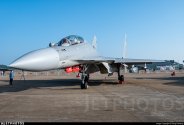
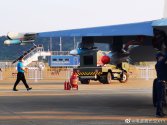
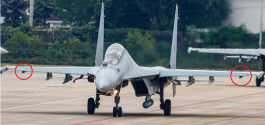
However, I recently saw a diagram showing that the J-15T (the catapult-capable variant) has further reduced the width of its folded airframe from 7.4m (on the Su-33/J-15) to 7.1m. Doesn't this exacerbate the problem? Is this diagram authentic? What could be the reason for such a modification?
I'm not sure if that is the case. I've seen no clear indicators that the folded wingspan has changed between J-15 and J-15T.
…
I'm not sure if that is the case. I've seen no clear indicators that the folded wingspan has changed between J-15 and J-15T.
IMO it did not
I mean, the first picture was at Zhuhai last year which was on the mainland.
That said I'm surprised that they are allowing people to talk shelter from the rain under the aircraft so close.
Despite the PLA having such tight opsec in many ways, in other ways they are surprisingly open, or even lax.
3:00 mark reminds me of how far China has come. It was only two decades ago and ex-Varyag was under tow through the Bosphorus strait with foreigner tug boat assistance , and now China has it's indigenous version self-propelled by its own engines to HK!!Nice video of Hongkong Visit
Surprised that no one cosplayed Asuka to recreate that scene with a UN Su-33.J-15T: S-stop looking so closely! *blushes*
View attachment 155573View attachment 155572View attachment 155575View attachment 155576View attachment 155574

